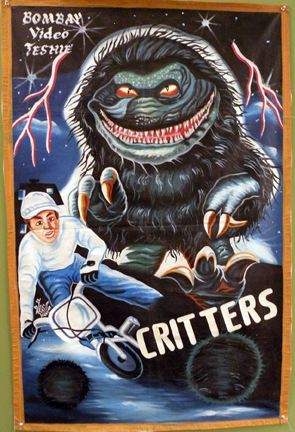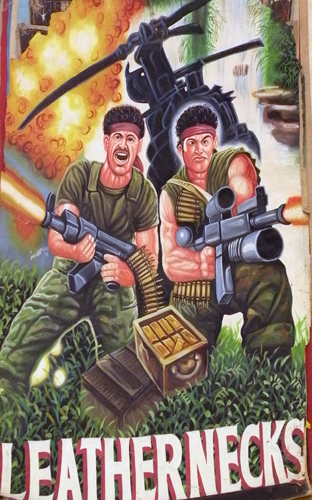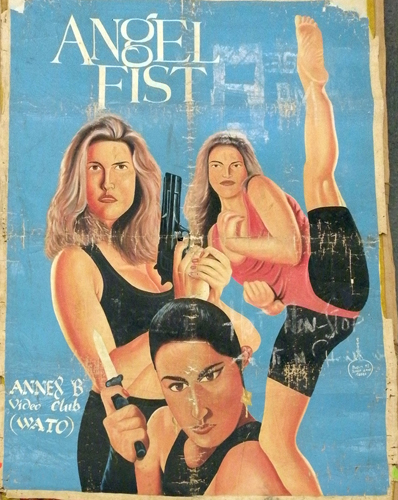Hand-Painted Movie Posters from Ghana A bold take on cinema
September 28, 2015
I recently learned about the Escalette Collection’s large collection of hand-painted movie posters from Ghana. I had seen a couple of the posters before, but I had no idea where they had come from, and just how many there were in the collection. The Escalette Collection is home to sixty five of these unique and boldly colored renditions of Hollywood B-movies, ninja movies, Bollywood films and African films. I was particularly fascinated by these movie posters in part because I am a film student, and also because my family is from Ghana.
 I was able to learn much more about the posters by reading the books Extreme Canvas and Extreme Canvas 2 by Ernie Wolfe III. These books give information on the history of the hand-painted poster tradition in Ghana, based on the author’s trips to Ghana and his interviews with many of the artists. Additionally, the books provide high resolution images of hundreds of posters from what is now known as the Golden Age of movie posters, which took place from 1985 to 1998.
I was able to learn much more about the posters by reading the books Extreme Canvas and Extreme Canvas 2 by Ernie Wolfe III. These books give information on the history of the hand-painted poster tradition in Ghana, based on the author’s trips to Ghana and his interviews with many of the artists. Additionally, the books provide high resolution images of hundreds of posters from what is now known as the Golden Age of movie posters, which took place from 1985 to 1998.
At the time when hand painted movie posters started to become popular, hand painted advertisements were already commonplace in urban Ghanaian settings. Painted ads donned the storefronts of barber shops, tailors and shoeshiners, using boldly colored imagery to display the shop’s services. Several artists were university trained, while many others perfected their craft through a master-apprentice program.
The shift from painted ads to painted movie posters came with the rise in popularity of the VCR and the gas powered generator. These technologies allowed for community film screenings in any part of the country, even in rural areas. Entrepreneurs took advantage of this activity and created their own mobile film distribution businesses. These distributors would carry around videocassettes, VCRs, TV monitors and generators and screen a variety of films in family homes or communal meeting centers. These screenings became a popular nighttime activity in Ghana. But no business is complete without advertising – this is where the hand-painted movie posters come in.

Hand-painted movie posters were hung by the screening areas in order to entice potential viewers. The posters had to be colorful and eyecatching, and often depicted scenes of gore, violence and sexuality that were taboo in most traditional African commercial art. These posters were unique to Ghana, and often pushed boundaries that American printed movie posters did not even come close to.
Alex Nkrumah-Boateng is credited with beginning the movie poster painting trend back in 1985. Other prolific artists spawned from the coastal regions around Accra and further out into the Kumasi region as well, including artists such as Joe Mensah, D.A. Jasper and Leonardo to name a few. Artists became poster painters through a traditional four year apprenticeship program. Movie poster painting became a very lucrative business for these artists. As more and more artists hopped on board, distinct styles began to emerge in each region. The coastal artists leaned more toward realism, putting great focus into the tiny details, while the Kumasi artists tended to be more abstract. The qualities that both groups shared, however, were the use of bold colors and the ‘in your face’ subject matter.
What sets these hand-painted movie posters apart from the printed movie posters of the West is the artist’s mindset. Oftentimes, the Ghanaian artists would base their work off one viewing of the film. In some cases, a synopsis from a friend who had seen the film would be enough. With no conventions or studios to pander to, the Ghanaian artists would let their imaginations run wild. Each individual artist would assert their own unique style, making no two posters appear alike. This type of creativity in advertising is now often stifled by the more formulaic and traditional forms that we see in printed ads today.
 These dazzling posters were a significant part of the Ghanaian film distribution industry for many years. However, in the late 90s, mobile cinemas and video clubs began to dissipate. Europeans began to provide more video titles to local marketplaces, along with printed posters which were able to be reproduced in mass amounts. And as more families were owning TVs, movie watching became more of a single-family activity, rather than a community event. Within a couple years, hand-painted movie posters were a thing of the past.
These dazzling posters were a significant part of the Ghanaian film distribution industry for many years. However, in the late 90s, mobile cinemas and video clubs began to dissipate. Europeans began to provide more video titles to local marketplaces, along with printed posters which were able to be reproduced in mass amounts. And as more families were owning TVs, movie watching became more of a single-family activity, rather than a community event. Within a couple years, hand-painted movie posters were a thing of the past.
The hand-painted movie poster phenomenon of Ghana was a great art form that was diminished by technological advancements. While these posters haven’t been a hot commodity since 1998, audiences all over the world continue to appreciate the bold creativity of these one of a kind posters. As most of the posters were painted on flour sacks or canvas that was rolled up over and over again, many of the posters from the Golden Age have been damaged beyond repair. But luckily, the Escalette Collection has plenty for the Chapman community to enjoy for years to come. Hopefully we can all expand our knowledge of Ghanaian art and its influence on the history of cinema!

